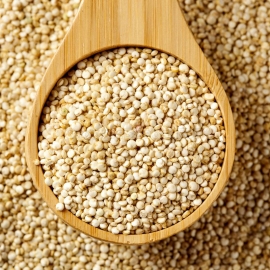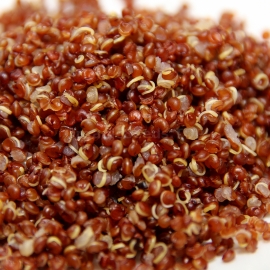 EXCLUSIVE
EXCLUSIVE
Organic White Quinoa Seeds (Chenopodium Quinoa)
1.14 €
Quinoa is a species of the goosefoot genus (Chenopodium quinoa), a grain crop grown primarily for its edible seeds. It is a pseudocereal rather than a true cereal, as it is not a member of the true grass family.
-
Organic White Quinoa (Chenopodium Quinoa)
Quinoa is a species of the goosefoot genus (Chenopodium quinoa), a grain crop grown primarily for its edible seeds. It is a pseudocereal rather than a true cereal, as it is not a member of the true grass family.
As a chenopod, quinoa is closely related to species such as beetroots, spinach and tumbleweeds. As a member of the Amaranthaceae family, it is related to and resembles amaranth, which is also a pseudocereal.
Quinoa (the name is derived from the Spanish spelling of the Quechua name kinwa) originated in the Andean region of Chile, Peru, Bolivia, Ecuador and Colombia, where it was domesticated 3,000 to 4,000 years ago for human consumption, though archaeological evidence shows a non-domesticated association with pastoral herding some 5,200 to 7,000 years ago.
Similar Chenopodium species, such as pitseed goosefoot (Chenopodium berlandieri) and fat hen (Chenopodium album), were grown and domesticated in North America as part of the Eastern Agricultural Complex before maize agriculture became popular. Fat hen, which has a widespread distribution in the Northern Hemisphere, produces edible seeds and greens much like quinoa, but in smaller quantities.
The nutrient composition is favourable compared with common cereals. Quinoa seeds contain essential amino acids like lysine and acceptable quantities of calcium, phosphorus, and iron.
After harvest, the seeds must be processed to remove the coating containing the bitter-tasting saponins. The seeds are in general cooked the same way as rice and can be used in a wide range of dishes. The leaves are eaten as a leaf vegetable, much like amaranth, but commercial availability of quinoa greens is limited.
Products Viewed Before
Product code: 12087
1.14 €
A hardy, high yielding variety with vivid pinkish-red seed heads. Selected to withstand some moisture when mature (less occurance of sprouting in the head). Variety originated in South America. Yields a high protein seed "grain".

